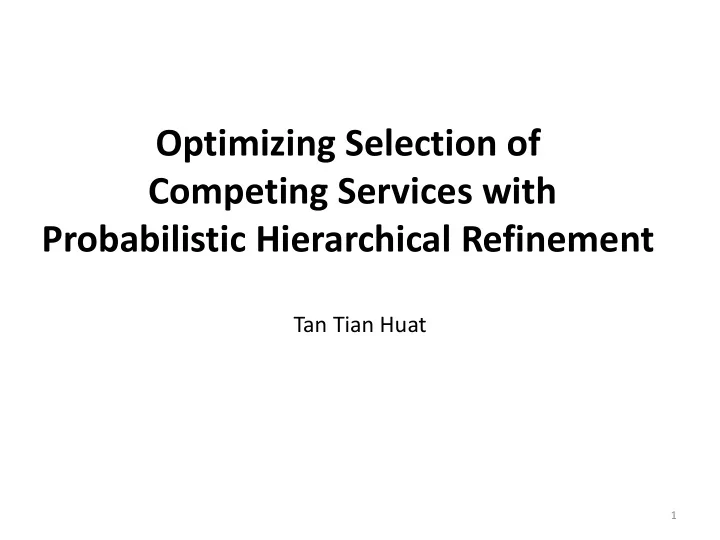

Optimizing Selection of Competing Services with Probabilistic Hierarchical Refinement Tan Tian Huat 1
Competing Services – Example 1 Car Booking Services Hotel Booking Services 2
Competing Services – Example 2 • Netflix – A global provider of streaming movies and TV series – leverages Microservice Architecture (opposed to monolithic architecture) – Advantages: • Strong module boundaries • Independent Deployment • Technology Diversity 3
Competing Services – Example 2 4
Composite Service Composite Service: A service that leverages other existing services for achieving a business goal. Flight Hotel Request Reply Booking Service Booking Service User from User (FBS) (HBS) Travel Agency Composite Service (TAS) Abstract service (e.g., Hotel Booking Service) Concrete service (e.g., the Hilton Hotel booking service) Abstract Composite Service Concrete Composite Service 5
Quality of Service (QoS) • Type of QoS Concrete Response Cost Services Times (ms) – Positive f 1 200 10 • Availability f 2 100 20 – Negative f 3 50 30 • Cost, Response Time • QoS Constraints (can be due to Service Level Agreement) – Response time < 50 ms, Cost < $20 • QoS Optimality: The best QoS based on user preference. 6
Optimal Service Selection Given a composite service: – For each abstract service (e.g., a hotel booking service) – Select a concrete service (e.g., the Hilton Hotel booking service) for the abstract service at runtime. – Maximize the QoS optimality. – Satisfy all QoS constraints. An NP Hard Problem! 7
Probabilistic Hierarchical Refinement (ProHR) No Feasible Selection Abstract Composite Concrete Hierarchical Service Probabilistic Preprocessing Composite Ranking Refinement Service 8
Probabilistic Hierarchical Refinement (ProHR) No Feasible Selection Abstract Composite Concrete Hierarchical Service Probabilistic Preprocessing Composite Ranking Refinement Service 9
Preprocessing Unsatisfiable Services Pruning ≤ 600ms Concrete Service for FBS f 1 ,f 2 ,f 3 ,f 4 FBS HBS Concrete Service for HBS Concrete Response h 1 ,h 2 ,h 3 ,h 4 Availability Services Times (ms) f 1 /h 1 100 0.85 f 2 /h 2 300 0.92 f 3 /h 3 500 0.95 f 4 600 0.94 h 4 600 0.8 Concrete Services for TAS 10
Preprocessing Non-Skyline Services Pruning ≤ 600ms ≤ 600ms Concrete Service for FBS f 1 ,f 2 ,f 3 ,f 4 FBS HBS Concrete Service for HBS Concrete Response h 1 ,h 2 ,h 3 ,h 4 Availability Services Times (ms) f 1 /h 1 100 0.85 f 2 /h 2 300 0.92 f 3 /h 3 500 0.95 f 4 600 0.94 h 4 600 0.8 Concrete Services for TAS 11
Probabilistic Hierarchical Refinement (ProHR) No Feasible Selection Abstract Composite Concrete Hierarchical Service Probabilistic Preprocessing Composite Ranking Refinement Service 12
Probabilistic Ranking • Ranked the candidate concrete services for an abstract service according their – Local Optimality (L(s)) • The local QoS optimality of a service – Constraint Satisfaction Probability (P(s)) • How likely a service can satisfy the global constraints. Concrete Response Availability L(s) P(s) L(s)*P(s) Services Times (ms) f 1 /h 1 100 0.85 0.5 0.25 0.125 f 2 /h 2 300 0.92 0.6 0.5 0.3 f 3 /h 3 500 0.95 0.5 0.25 0.125 13
Probabilistic Ranking – Local Optimality Concrete Response Service Ranking: Availabilit Services Times L(s) P(s) L(s)*P(s) y (ms) FBS HBS f 1 /h 1 100 0.85 0.5 0.25 0.125 f 2 h 2 f 2 /h 2 300 0.92 0.6 0.5 0.3 f 1 h 1 f 3 /h 3 500 0.95 0.5 0.25 0.125 f 3 h 3 Why f 2 /h 2 ranks the highest in L(s): • f 3 /h 3 has the worst response time • f 1 /h 1 has the worst availability • f 2 /h 2 is “just nice” 14
Probabilistic Ranking – Constraint Satisfaction Probability Concrete Response Service Ranking: Availabilit Services Times L(s) P(s) L(s)*P(s) y (ms) FBS HBS f 1 /h 1 100 0.85 0.5 0.25 0.125 f 2 h 2 f 2 /h 2 300 0.92 0.6 0.5 0.3 f 1 h 1 f 3 /h 3 500 0.95 0.5 0.25 0.125 f 3 h 3 Response time≤ 600ms, Availability≥ 0.8 Response time: 300ms for each abstract service Availability: 0.9 for each abstract service FBS HBS Local Constraints Global Constraints Why f 2 /h 2 ranks the highest in P(s): • It is the only one that fit the local constraint well • f 1 /h 1 does not match for availability • f 3 /h 3 does not match for response time 15
Probabilistic Hierarchical Refinement (ProHR) No Feasible Selection Abstract Composite Concrete Hierarchical Service Probabilistic Preprocessing Composite Ranking Refinement Service 16
Hierarchical Refinement Optimal selection using Mixed Integer Linear Programming (e.g., Gurobi, r=1 lpsolver) <f 2 >, <h 2 > FBS HBS f 2 h 2 f 1 h 1 f 3 h 3 17
Hierarchical Refinement Optimal selection using Mixed Integer Linear Programming (e.g., Gurobi, r=1 lpsolver) <f 2 >, <h 2 > FBS HBS <f 2 , f 1 , f 3 >, r=2 f 2 h 2 <h 2 , h 1 , h 3 > f 1 h 1 f 3 h 3 How many services to choose at each round? • P(S) is the probability that given an abstract service, at least one concrete service successfully satisfies the global constraints. • P(S)> Threshold • Threshold is increased with the number of round. 18
Hierarchical Refinement r = 1 r = 2 . . . . . All Services included We will find a solution if there is one. 19
Experiments Result 20
At a Higher Level Hierarchical Probabilistic Search Preprocessing Ranking Refinement Algorithms 21
On a Higher Perspective ProHR 1. Preprocessing -> Delete unsuitable candidate 2. Ranking -> Rank the candidates probabilistically 3. Hierarchical Refinement -> Select the ranked candidates probabilistically 22
Conclusion Conclusion • We propose Probabilistic Hierarchical Refinement (ProHR) • On a higher level - an approach that can be integrated with searching techniques (e.g., MIP, EA) for NP-hard problems. 23
Questions? 24
Recommend
More recommend